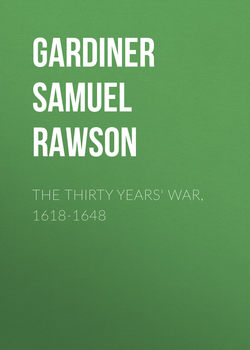The Thirty Years' War, 1618-1648

Реклама. ООО «ЛитРес», ИНН: 7719571260.
Оглавление
Gardiner Samuel Rawson. The Thirty Years' War, 1618-1648
PREFACE
CHAPTER I. CAUSES OF THE THIRTY YEARS' WAR
Section I. —Political Institutions of Germany
Section II. —Protestantism in Germany
Section III. —Reaction against Protestantism
Section IV. —Three Parties and Three Leaders
CHAPTER II. THE BOHEMIAN REVOLUTION
Section I. —The House of Austria and its Subjects
Section II. —The Revolution at Prague
Section III. —The War in Bohemia
Section IV. —Ferdinand on his Defence
CHAPTER III. IMPERIALIST VICTORIES IN BOHEMIA AND THE PALATINATE
Section I. —The Attack upon Frederick
Section II. —The War in the Upper Palatinate
Section III. —Frederick's Allies
Section IV. —The Fight for the Lower Palatinate
CHAPTER IV. MANSFELD AND CHRISTIAN IN NORTH GERMANY
Section I. —Mansfeld's March into the Netherlands
Section II. —Christian of Brunswick in Lower Saxony
Section III. —Danger of the Lower Saxon Circle
Section IV. —England and France
Section V. —Rise of Richelieu
CHAPTER V. INTERVENTION OF THE KING OF DENMARK
Section I. —Christian IV. and Gustavus Adolphus
Section II. —English Diplomacy
Section III. —Wallenstein's Armament
Section IV. —Defeat of Mansfeld and Christian IV
CHAPTER VI. STRALSUND AND ROCHELLE
Section I. —Fresh Successes of Wallenstein
Section II. —Resistance to Wallenstein in the Empire
Section III. —The Siege of Stralsund
Section IV. —The Siege of Rochelle
CHAPTER VII. THE EDICT OF RESTITUTION
Section I. —Oppression of the Protestants
Section II. —French Intervention in Italy
Section III. —Wallenstein deprived of his Command
Section IV. —The Swedes establish themselves on the Coast of the Baltic
Section V. —The Fall of Magdeburg
CHAPTER VIII. THE VICTORIES OF GUSTAVUS ADOLPHUS
Section I. —Alliance between the Swedes and the Saxons
Section II. —The Battle of Breitenfeld
Section III. —March of Gustavus into South Germany
Section IV. —Wallenstein's Restoration to Command
Section V. —The Struggle between Gustavus and Wallenstein
Section VI. —The Battle of Lützen
CHAPTER IX. THE DEATH OF WALLENSTEIN AND THE TREATY OF PRAGUE
Section I. —French Influence in Germany
Section II. —Wallenstein's Attempt to dictate Peace
Section III. —Resistance to Wallenstein's Plans
Section IV. —Assassination of Wallenstein
Section V. —Imperialist Victories and the Treaty of Prague
CHAPTER X. THE PREPONDERANCE OF FRANCE
Section I. —Open Intervention of France
Section II. —Spanish Successes
Section III. —The Struggle for Alsace
Section IV. —French Successes
Section V. —Aims and Character of Richelieu
Section VI. —More French Victories
CHAPTER XI. THE END OF THE WAR
Section I. —Turenne's Strategy
Section II. —The Treaty of Westphalia
Section III. —Condition of Germany
Section IV. —Continuance of the War between France and Spain
Отрывок из книги
It was the misfortune of Germany in the sixteenth and seventeenth centuries that, with most of the conditions requisite for the formation of national unity, she had no really national institutions. There was an emperor, who looked something like an English king, and a Diet, or General Assembly, which looked something like an English Parliament, but the resemblance was far greater in appearance than in reality.
The Emperor was chosen by three ecclesiastical electors, the Archbishops of Mentz, Treves and Cologne, and four lay electors, the Elector Palatine, the Electors of Saxony and Brandenburg, and the King of Bohemia. In theory he was the successor of the Roman Emperors Julius and Constantine, the ruler of the world, or of so much of it at least as he could bring under his sway. More particularly, he was the successor of Charles the Great and Otto the Great, the lay head of Western Christendom. The Emperor Sigismund, on his death-bed, had directed that his body should lie in state for some days, that men might see 'that the lord of all the world was dead.' 'We have chosen your grace,' said the electors to Frederick III., 'as head, protector, and governor of all Christendom.' Yet it would be hard to find a single fragment of reality corresponding to the magnificence of the claim.
.....
In this way eight of the great northern bishoprics soon came under Protestant rule. Not that the Protestant occupant was in any real sense of the word a bishop. He was simply an elected prince, calling himself a bishop, or often more modestly an administrator, and looking after the temporal affairs of his dominions.
In some respects the arrangement was a good one. The populations of these territories were mainly Protestant, and they had no cause to complain. Besides, if only a sufficient number of these bishoprics could be gained to Protestantism, the factitious majority in the Diet might be reversed, and an assembly obtained more truly representing the nation than that which was in existence. But it must be acknowledged that the whole thing had an ugly look; and it is no wonder that Catholics pronounced these administrators to be no bishops at all, and to have no right to hold the bishops' lands, or to take their seat as bishops in the Diet of the Empire.
.....